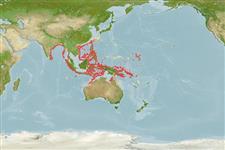Teleostei (teleosts) >
Scombriformes (Mackerels) >
Scombridae (Mackerels, tunas, bonitos) > Scombrinae
Etymology: Rastrelliger: Latin, rastra = rake + Latin, gero = to carry.
Eponymy: James Lawrence Faughn (1910–1985) worked at the Scripps Institution of Oceanography (1947–1974). [...] (Ref. 128868), visit book page.
Environment: milieu / climate zone / depth range / distribution range
Ecology
Marine; pelagic-neritic; oceanodromous (Ref. 51243); depth range 2 - 150 m (Ref. 128967). Tropical; 26°N - 14°S, 78°E - 157°E (Ref. 168)
Indo-West Pacific: India to Fiji, north to Taiwan.
Size / Weight / Age
Maturity: Lm ? range ? - ? cm
Max length : 20.0 cm FL male/unsexed; (Ref. 168); max. published weight: 750.00 g (Ref. 168)
Dorsal spines (total): 8 - 11; Dorsal soft rays (total): 12; Anal spines: 0; Anal soft rays: 12; Vertebrae: 31. Head longer than body depth. Maxilla covered by lachrymal bone. Swim bladder present. Interpelvic process small and single. Anal spine rudimentary. Bristles on longest gill raker, 30 to 55 on one side. Gill rakers do not extend far into mouth. A black blotch behind pectoral fin base. The belly is yellowish silver; 2 to 6 large spots are at the base of the first dorsal fin; tow faint stripes are at the level of the lateral line in some specimens.
Epipelagic, neritic species, occurring in waters where surface temperatures do not fall below 17°C. Forms schools of equally sized individuals. Feeds on the largest zooplankton organisms, thus complementing the planktonic food spectrum of the other two Rastrelliger species.
Life cycle and mating behavior
Maturity | Reproduction | Spawning | Eggs | Fecundity | Larvae
Collette, B.B. and C.E. Nauen, 1983. FAO Species Catalogue. Vol. 2. Scombrids of the world. An annotated and illustrated catalogue of tunas, mackerels, bonitos and related species known to date. Rome: FAO. FAO Fish. Synop. 125(2):137 p. (Ref. 168)
IUCN Red List Status (Ref. 130435: Version 2024-1)
Threat to humans
Harmless
Human uses
Fisheries: commercial; gamefish: yes
Tools
Can't connect to MySQL database fbquizv2. Errorcode: Too many connections
